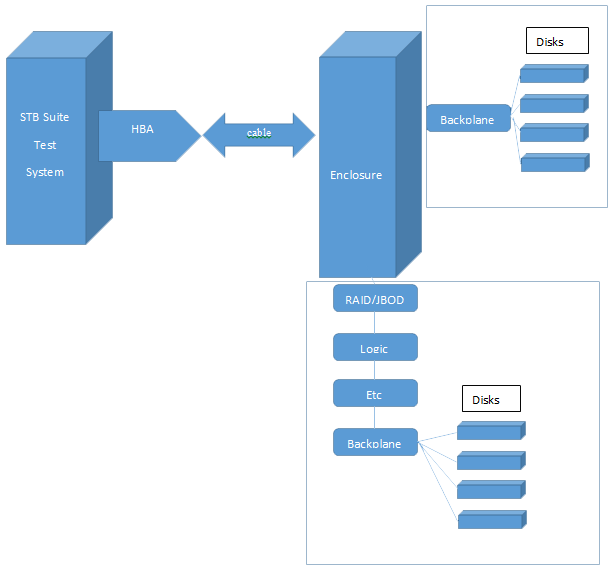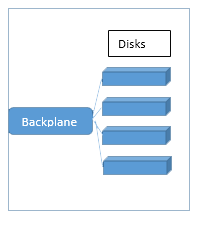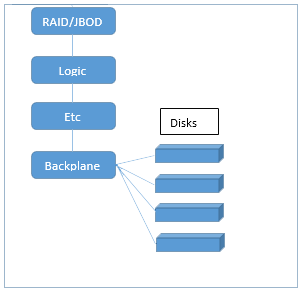Your goal – test a drive, or a bunch of drives.
 So, you connect the drive(s) to your test system, run the STB Suite, and look at results.
So, you connect the drive(s) to your test system, run the STB Suite, and look at results.
Some drives pass, others fail. Or all pass. Or fail.
But wait!
What passed? Or more important in the case of failure, what failed?
The drive you tested? Or something else?
What exactly are you testing when you test that drive?
Well, in actuality you are testing every component or cable or device between the STB Suite software and the drive you ultimately need to test.
Look at this drawing –

It shows your test environment with these components :
- Test System (computer)
- HBA
- Cable
- Enclosure
Four pieces of equipment so far… then within the enclosure you will either have
- Backplane with connectors, like this

- and disks
Or
- RAID/JOB active circuitry
- Enclosure services circuitry
- Other monitoring circuits
- Backplane
- And disks, like this

Then finally
Either 6. or 9. the disk(s) you want to test.
So – either 6 or 9 “things” in the data path, all “being tested” during your disk test.
In other words – 6 or 9 different pieces of equipment, all of which could fail and make you think that a perfectly good disk drive has a problem when in fact it doesn’t!
When test results show that a drive failed but in fact it didn’t that is known as a false negative.
And false negative results can cost you time, money, and customer good will, and so should be avoided whenever possible.
The way to avoid false negatives and the way to insure that what your test results reflect are the state of the disks is to make certain that every piece of equipment or cable between the disk and the HBA is as transparent and perfect as possible.
Every component or cable needs to be perfect. That includes using cables designed for the speed of the hardware they are connecting.
Scrimping anywhere along the data path is a recipe for false negative results!
The first way to insure this is to simplify! Components or equipment which isn’t there can’t fail!
Simplify! The setup that doesn’t have RAID, Enclosure processors, other monitors, etc. is going to give better results than one with all these non-essential extras.
Q: Why do we recommend that you do NOT have any RAID components in your test system, even if they have a JBOD mode?
A: Because fewer components in the test path is better.
So with that in mind the test setup above will be inherently more reliable if you set it up like shown with the drives to the right of the enclosure, rather than the more complicated setup shown where the drives are below the enclosure.
Less is better!
More complexity anywhere along the data path = a recipe for false negatives.
Keep your test system as simple as possible.
Eliminate as much from the data path as you can.
Keep in mind what you are testing in your test setup – simplify as much as you can for the best consistent results!